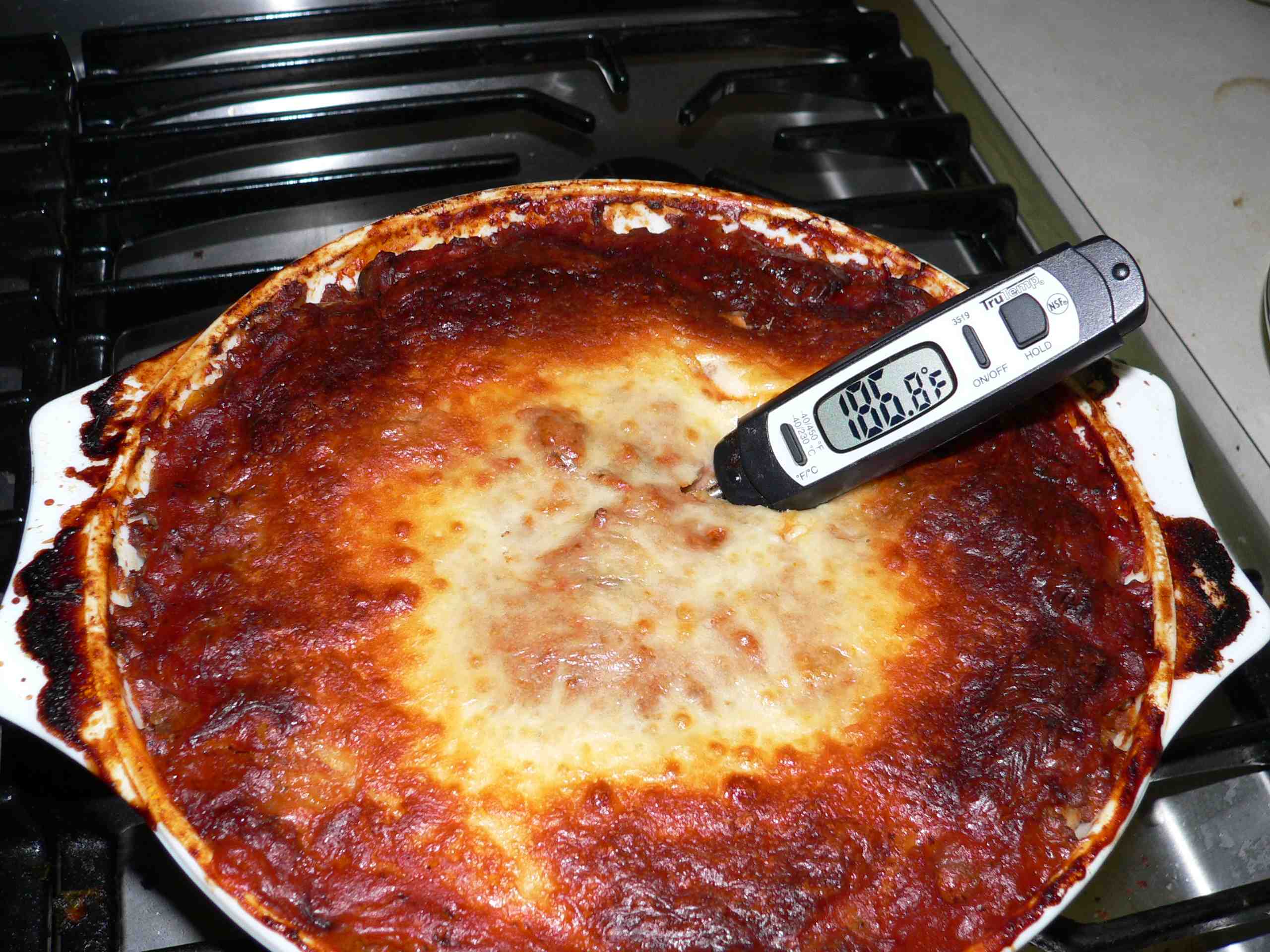We’ve been visiting with some of Amy’s family in Minnesota the past few days. Dinner for the gang last Sunday in Andover, north of Minneapolis, featured a couple of frozen Stouffer’s lasagnas.
 Two lasagnas were required to feed the crew, and were cooked in the oven at the same time.
Two lasagnas were required to feed the crew, and were cooked in the oven at the same time.
Although the recommended cooking procedure was followed, the result was still-frozen-in-the-middle lasagna. Two frozen lasagnas take longer than one. Amy says it’s physics.
Being the food safety nerd, I wondered aloud if the frozen lasagna was made with raw ingredients – which would need to be cooked to 160F — or cooked ingredients, meaning 135F would be fine. We rationalized, it’s lasagna, probably cooked ingredients, but 160F just in case. Aunt Jean brought out her oven-friendly thermometer and dinner was great.
The label on the Stouffer’s package had lots of cooking instructions and lots of mentions of food safety, but nothing about raw or cooked ingredients, and nothing about final cooking temperature. In really tiny print, a label proclaimed the product had been inspected by the U.S. Department of Agriculture.
That’s when I became worried.
 I attempted to call the Stouffer’s consumer hotline , but it’s only open Monday to Friday, because people don’t eat frozen entrees on the weekend.
I attempted to call the Stouffer’s consumer hotline , but it’s only open Monday to Friday, because people don’t eat frozen entrees on the weekend.
I called the hotline again on Monday and a nice lady told me that yes, two lasagnas take longer than one, and that she has instructions for proper cooking of two lasagnas at once – but nothing on the label or website. Did I mention the hotline wasn’t open Sunday?
The nice lady said the meat ingredients were all cooked, but that the lasagna should be cooked to 160F. “Yes, 160F is exactly what it should be cooked to.”
I’d argue 135F is sufficient, but regardless, there was nothing on the label about final cooking temperature, nothing about using a digital, tip-sensitive or some other type of accurate measuring device.
Pathogens in frozen lasagna have been linked to human illness on at least one previous occasion, earlier this year.
.jpg) "The owner of Mona Lisa pasta says his kitchen is not to blame for six central Virginia dinner guests coming down with salmonella. While he says he sold the frozen lasagna, it was not his kitchen that was responsible for cooking it to code.
"The owner of Mona Lisa pasta says his kitchen is not to blame for six central Virginia dinner guests coming down with salmonella. While he says he sold the frozen lasagna, it was not his kitchen that was responsible for cooking it to code.
"The customer has written instructions as to how to prepare the food, to bake at a certain temperature for a certain amount of time, and that’s a food-safe temperature.”
I wonder how thorough those label instructions on safe cooking really were.
Sure, most people will not follow food safety labels, as we’ve found out with our own experiments, but it’s up to food manufacturers to provide complete and accurate food safety labels. And encourage thermometer use. How else are people going to be encouraged to stick it in?
That’s Sorenne with great-grandma Lorraine (below).

 Smells like victory.
Smells like victory.



 Two lasagnas were required to feed the crew, and were cooked in the oven at the same time.
Two lasagnas were required to feed the crew, and were cooked in the oven at the same time. I attempted to call the Stouffer’s consumer hotline , but it’s only open Monday to Friday, because people don’t eat frozen entrees on the weekend.
I attempted to call the Stouffer’s consumer hotline , but it’s only open Monday to Friday, because people don’t eat frozen entrees on the weekend..jpg) "The owner of Mona Lisa pasta says his kitchen is not to blame for six central Virginia dinner guests coming down with salmonella. While he says he sold the frozen lasagna, it was not his kitchen that was responsible for cooking it to code.
"The owner of Mona Lisa pasta says his kitchen is not to blame for six central Virginia dinner guests coming down with salmonella. While he says he sold the frozen lasagna, it was not his kitchen that was responsible for cooking it to code.
